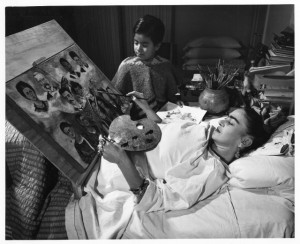About Frida Kahlo
Frida Kahlo was born on July 6, 1907, in Coyocoán, Mexico City, Mexico. Considered one of Mexico’s greatest artists, Frida Kahlo began painting after she was severely injured in a bus accident. Kahlo later became politically active and married fellow communist artist Diego Rivera in 1929.
Kahlo grew up in the family’s home where she was born. Her father, Wilhelm, was a German photographer who had immigrated to Mexico where he met and married her mother Matilde. She had two older sisters, Matilde and Adriana, and a younger sister, Cristina. Around the age of 6, she contracted polio, which caused her to be bedridden for nine months. While she did recover from the illness, she limped when she walked because the disease had damaged her right leg and foot. She was harshly nicknamed “peg-leg Frida” by others.
In 1922, Kahlo enrolled at the renowned National Preparatory School. She was one of the few female students to attend the school.
At the age of eighteen, she got into an automobile collision as she was riding a street car and fractured her spine and pelvis. Kahlo’s disabilities drastically changed the path of her life. Her original ambition was to be a doctor; it was after her accident that Kahlo began to paint. She painted in order to keep herself busy, but furthermore, it was a form of therapy. Painting allowed Kahlo to ease her emotional and physical struggles as a misunderstood woman who was hidden beneath her masculine features and clothes, and her physical disabilities.
After staying at the Red Cross Hospital in Mexico City for several weeks, Kahlo returned home to recuperate further. She began painting during her recovery and finished her first self-portrait the following year, which she gave to Gómez Arias. Becoming more politically active, Kahlo joined the Young Communist League and the Mexican Communist Party.
Kahlo was saddened by Rivera’s many infidelities, including an affair with her sister Cristina. Desperately wanting to have a child, she again experienced heartbreak when she miscarried in 1934. She and Rivera went through periods of separation, but they eventually got back together.
In 1939, Kahlo went to live in Paris for a time. There she exhibited some of her paintings and developed friendships such artists as Marcel Duchamp and Picasso. She divorced Rivera later that year. During this time, she painted one of her most famous works, Las Dos Fridas (1939). The painting shows two versions of the artist sitting side by side, with both of their hearts exposed. One Frida is dressed nearly all in white and has a damaged heart and spots of blood on her clothing. The other wears bold colored clothing and has an intact heart. These figures are believed to represent “unloved” and “loved” versions of Kahlo.
In 1942, Frida Kahlo was elected a member of the Seminario de Cultura Mexicana, a group whose mission was to promote Mexican culture. In 1943, she was appointed to the staff of the newly founded School of Painting and Sculpture. She was then presented with the Mexican Award of Art and Science in 1946.
Kahlo was a sexually liberated woman and was openly bisexual, which was extremely scandalous during this time; she was a victim of a patriarchal Mexican culture, and she pushed the boundaries of what a woman was supposed to be and what she was supposed to look like. Later in life, she taught art classes to high school students and became a passionate mentor to several successful artists. She exhibited her paintings in Paris and Mexico before her death in 1958. She sets a historical precedent for women by showing that all women can be strong and make a difference for the next generation of women to come.

Recent Comments